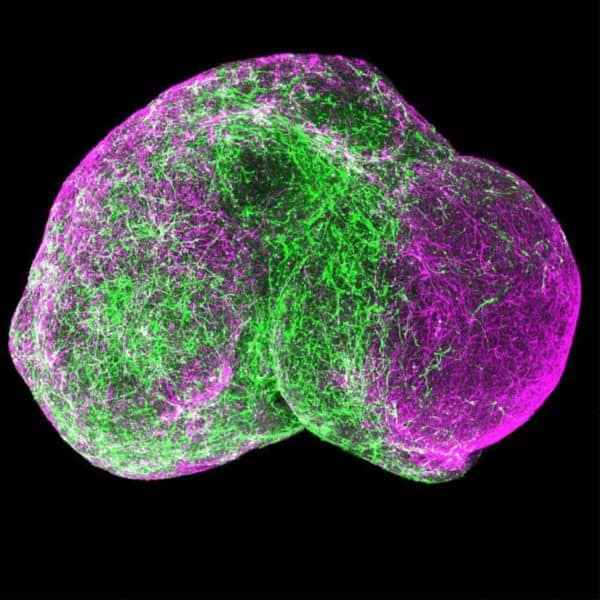This striking image captures nerve cells (in green) migrating from one region of the human forebrain into another region — in laboratory glassware. This process recapitulates what’s been believed to occur in a developing fetus, but has never previously been viewed in real time.
The seeds of autism, schizophrenia and other neurodevelopmental disorders are planted during the formation of the brain’s complex circuitry, which largely occurs during the second half of pregnancy. That’s not the kind of thing scientists can zoom in on. So, figuring out where the intense wire-up underway in a developing human forebrain went wrong is, understating it, a challenge.
Stanford neuroscientist Sergiu Pasca, MD, has a workaround: He derives so-called neural spheroids from “induced pluripotent stem cells,” or iPS cells, which can both live happily in a lab dish and be coaxed to differentiate into, in principle, all of the 200-plus cell types — muscle, bone, heart, nerve, etc. — making up our bodies. (Because iPS cells can be produced from skin cells — anybody’s skin cells — the downstream cell types derived from them genetically mirror those of whoever the skin cells came from.)
“Culturing neurons in a lab dish is old hat,” as I wrote in a news release about Pasca’s new study in Nature. But standard, two-dimensional culture on coated glass slides doesn’t sit well with neurons, which are designed to thrive in three dimensions. They mature only partially, tend to die fairly quickly and interact suboptimally.
In a 2015 study, Pasca’s team created neural spheroids by placing neural precursor cells generated from iPS cells into culture dishes whose bottoms were coated to make it impossible for neurons to attach. Floating freely in a nutrient-rich broth, the cells ultimately blossomed into hundreds of almost perfectly round balls approaching 1/16 of an inch in diameter and consisting of over 1 million cells each. The neurons matured fully and lived for up to two years.
The neural spheroids in that study recapitulated the human cerebral cortex’s six-layer-thick architecture, and the only neurons they contained were the kind that arise in and dominate the cerebral cortex. During fetal development, these neurons are joined by an entirely different type of neurons originating in a deeper region of the developing forebrain. These neurons migrate from that region to the cortex, where they hook up with the native neurons to form the circuitry responsible for the brain’s most advanced activities. But no one’s ever been able to watch this happen with human cells in a dish.
In the new study, Pasca’s team generated spheroids representing both brain regions in separate dishes, then put them together in a third dish. Neural spheroids representing two different brain regions fused. Then, neurons from one spheroid migrated into the second one and forged working connections with its neurons.
When the researchers repeated this experiment using neurons derived from a patient with Timothy syndrome, which predisposes to autism, they saw that the migration process was disturbed — a major insight into the disease’s foundations.
Pasca’s 3-D technique may someday pinpoint similar developmental glitches responsible for schizophrenia, some types of autism and perhaps epilepsy.


